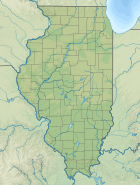| Tournament information | |
|---|---|
| Dates | June 19–23, 1975 |
| Location | Medinah, Illinois |
| Course(s) | Medinah Country Club, Course No. 3 |
| Organized by | USGA |
| Tour(s) | PGA Tour |
| Statistics | |
| Par | 71 |
| Length | 7,032 yards (6,430 m)[1] |
| Field | 150, 67 after cut |
| Cut | 149 (+7) |
| Prize fund | $235,700[2] |
| Winner's share | $40,000 |
| Champion | |
| 287 (+3), playoff | |
The 1975 U.S. Open was the 75th U.S. Open, held June 19–23, at Medinah Country Club in Medinah, Illinois, a suburb northwest of Chicago. Lou Graham defeated John Mahaffey by two strokes in an 18-hole Monday playoff to win his only major championship.[3][4]
Tom Watson shot 135 (−7) to tie the U.S. Open record for the first 36 holes of play,[5] but 155 (+13) on the weekend forced him down the leaderboard, three shots out of the Graham-Mahaffey playoff.[6] It marked the second straight year Watson failed to maintain a weekend lead in the championship; he was the 54-hole leader in 1974 at Winged Foot. He won the next major a month later in Scotland at Carnoustie.
Arnold Palmer finished in a tie for ninth place, his final top-10 finish at the U.S. Open. Jerry Pate tied for 18th place and shared low amateur honors with Jay Haas; Pate won the following year as a tour rookie.
Paired with Palmer was Masters champion Jack Nicklaus, who was two-under in the final round and just missed a birdie putt on the 15th green. He carded three consecutive bogeys to finish and ended up two strokes back.[6][7] Nicklaus rebounded and won the PGA Championship in August at Firestone.
The quality of the play was generally regarded as poor. Despite the high scores Jack Nicklaus said it was the "easiest" U.S. Open he had ever remembered playing. Runner-up John Mahaffey stated at the end of the event, "This course was never as difficult as the scores looked. I agree with everybody who said it was the easiest Open in history to have won. At least 10 guys could have won it by five shots if they'd played golf." The sportswriter Dan Jenkins regularly panned the performance of the players in his Sport Illustrated cover profile, stating in his opening sentence that "it was a golf tournament that begged to be forgotten."[4]
Since moving to the four-day format in 1965, this is the only U.S. Open in which the final round was not scheduled for Father's Day, the third Sunday in June.
This was the second U.S. Open at Medinah, the first was held in 1949. It later hosted in 1990, also a playoff, and the PGA Championship in 1999 and 2006, both won by Tiger Woods. Medinah was the venue for the Ryder Cup in 2012.
This was the final year that players were not allowed to have their own caddies at the U.S. Open.[8][9] The other majors and some PGA Tour events had traditionally disallowed players from using their own caddies.[10][11][12] The Masters required club caddies from Augusta National through 1982.[13][14][15]
- ^ "Deadlock at Medinah". Daytona Beach Morning Journal. (Florida). Associated Press. June 23, 1975. p. 4B.
- ^ "U.S. Open history: 1975". USGA. Archived from the original on May 11, 2012. Retrieved June 22, 2012.
- ^ Tomashek, Tom (June 24, 1975). "Graham wins Open title by 2 in playoff". Chicago Tribune. p. 1, sec. 4.
- ^ a b Jenkins, Dan (June 30, 1975). "It was madness at Medinah". Sports Illustrated. p. 18. Retrieved December 7, 2019.
- ^ "Tom Watson leading US Open by 3 shots". Bryan Times. (Ohio). UPI. June 21, 1975. p. 9.
- ^ a b Loomis, Tom (June 23, 1975). "Two escape Medinah stranglehold". Toledo Blade. (Ohio). p. 19.
- ^ Parascenzo, Marino (June 23, 1975). "Jack's Slam dream went 'Thrrrp'". Pittsburgh Post-Gazette. p. 16.
- ^ "Open golfers to pick own caddies in 1976". Toledo Blade. (Ohio). Associated Press. November 15, 1975. p. 17.
- ^ "Break for some". Rome News-Tribune. (Georgia). Associated Press. January 18, 1976. p. 3B.
- ^ Loomis, Tom (April 6, 1973). "Chi Chi prefers own caddy". Toledo Blade. Associated Press. p. 30.
- ^ "Westchester winner may bypass events". Victoria Advocate. (Texas). Associated Press. August 26, 1974. p. 1B.
- ^ "Touring golf pros prefer their own caddies". Reading Eagle. Associated Press. May 5, 1974. p. 76.
- ^ "Tour caddies at Augusta?". Times-News. (Hendersonville, North Carolina). November 12, 1982. p. 14.
- ^ Wade, Harless (April 6, 1983). "Tradition bagged at Masters". Spokane Chronicle. (Washington). p. C1.
- ^ Anderson, Dave (April 10, 1983). "New Masters caddies collide". Sunday Star-News. (Wilmington, North Carolina). p. 6D.

